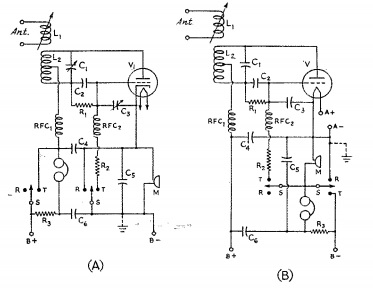At OneTubeRadio.com, we’e always looking for one tube radios, and seventy years ago, QST carried these circuits for a one-tube AM transceiver for VHF. Since the war had Amateur Radio shut down for the duration, this circuit was designed for WERS on 112 MHz.
The design also took wartime parts shortages into account, since the radio has about the bare number of parts possible to make a functioning transceiver. The author notes that almost any receiving tube can be used, and includes two circuit diagrams, one showing a directly cathode, and one with a separate cathode and filament. A prototype of the unit is shown, built in a cigar box. The antenna, a quarter-wave zepp, plugs into the top of the radio. (These days, a vertical zepp for VHF is better known as the J-pole.)
The circuit is basically a regenerative receiver, with a carbon microphone controlling current to the cathode. While the modulation percentage is low, the author calls it entirely adequate for short-haul work.
The author recommends a 6J5 tube for the circuit with a cathode, or a 1LE3 or 1G4 for the filament-only circuit, but almost any tube will work. The author does not offer any details as to performance (since he probably wasn’t able to test it on the air during the war). But he notes that “for a transceiver which costs only two dollars or less, as this one does, any attainable range should be satisfactory.”
It’s doubtful whether this simple circuit would meet the current FCC spectral purity requirements for use on the ham bands. After all, even while receiving, the regenerative receiver is radiating. However, if some attention is paid, it’s likely that this circuit would be legal on 49.82 – 49.90 MHz, under sections 15.235 and 15.23 of the FCC rules.
Interestingly, this isn’t the first time that the author of this article has been mentioned at this site. The QST article was written by Gurdon Abell, W2IXK. It appears that he later moved to Connecticut and was licensed as K1EHG after the war. He passed away in 1999 at the age of 82. He was mentioned here in an earlier post, and it wouldn’t be incorrect to say that he was the discoverer of meteor scatter communications on VHF.
You can find the original article and a few corrections on the ARRL website. To view these QST articles, you need to be logged in to your ARRL account.
Click Here For Today’s Ripley’s Believe It Or Not Cartoon
![]()


Pingback: 1957 Springfield Enterprises VHF Transceivers | OneTubeRadio.com
Pingback: 1938 Miniature UHF Transceiver | OneTubeRadio.com
Pingback: Wartime Emergency Radio Service (WERS) | OneTubeRadio.com
Hello,
I have been looking for plans/schematics for a one-tube 6 meter regenerative transceiver that I built in the early 60’s. It worked! I would like to build one again. The plans were originally published in one of the popular electronics rags of the time; 73, CQ, Electronics World, Boy Scout mag, Popular Electronics and the like.
It used a 12AT7, carbon mic and had a VFO!
Any thoughts?
Thanks,
Dan
w6hj
Suggestion under linked reg 15.235 is to meet 100 mW *input* power for this to be legal under current regs — even if that doesn’t count filament heating load, I don’t know if the circuit would oscillate at that power level, or if you’d be able to hear (at a guess) 0.1 mW TRP across the street. I’ve got a QRP rig that puts out close to a watt and runs on a single 9V battery. 100 mW is close to what you can get from a hearing aid battery.
Apparently anyone who experiments with radios at this technology level is required to own spectrum analyzers, o-scopes, etc. in order to be sure it’s legal to connect an antenna, else hook up only to a dummy load.
OK, and the regulation says it’s measured at the battery, so you probably have to include the filaments.
So I guess if someone wants to recreate this, they’ll need to have a license and do it on either 6 or 2 meters, and add some kind of filtering, probably even when it’s on receive.